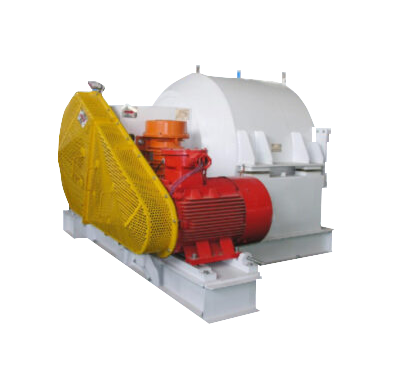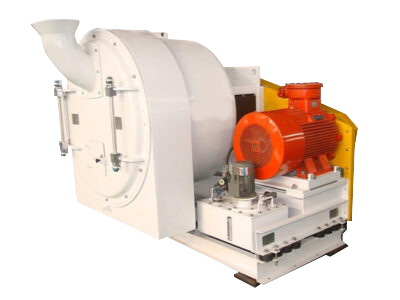What is a horizontal dewatering centrifuge?
Horizontal dewatering centrifuge is a device that uses centrifugal force for solid-liquid separation.
It usually consists of a horizontally placed drum and a screw conveyor. In operation, the material is fed into the drum rotating at high speed, due to the action of centrifugal force, the solid particles are thrown to the inner wall of the drum and gradually deposited to form a cake, while the liquid is thrown out through the filter screen or pores on the wall of the drum. The screw conveyor rotates at a speed slightly different from that of the drum and pushes the deposited solid cake to the slag discharge port, thus realising the continuous solid-liquid separation process.
Working principle of horizontal dewatering centrifuge
The working principle of the horizontal dewatering centrifuge is based on centrifugal force.
When the material to be treated enters the interior of the high-speed rotating horizontal drum through the feed tube, the solid particles in the material are subjected to an outward centrifugal force many times greater than their own gravity due to the presence of centrifugal force. Under the action of this powerful centrifugal force, the solid particles are rapidly deposited to the inner wall of the drum, forming a solid layer.
At the same time, the liquid part is thrown out of the drum under the action of centrifugal force through the filtering medium on the wall of the drum (e.g. filter mesh, filter cloth, etc.), and enters into the filtrate collection chamber.
The screw conveyor inside the drum rotates in the same direction with the drum at a certain differential speed, and the existence of the differential speed enables the screw conveyor to push the solid material deposited on the inner wall of the drum to the exit of the cone end of the drum, so as to realise continuous unloading.
In the whole process, the size of the centrifugal force depends on the rotational speed of the drum and the density difference between the solid particles and the liquid, the higher the rotational speed, the greater the centrifugal force, the better the separation effect.
Horizontal dewatering centrifuge has the following significant advantages:
1.High-efficiency separation capacity
Able to achieve efficient solid-liquid separation in a short period of time, large processing capacity, greatly improving production efficiency.
2.Good separation effect
Higher purity solid and clarified liquid can be obtained with higher separation precision.
3.Continuous operation
Continuous feeding, separating and discharging can be realised, and the operation process has a high degree of automation, which reduces manual intervention.
4.Wide applicability
Applicable to the separation of a variety of materials, including different particle size, density, viscosity and concentration of materials.
5.Small footprint
Compared with some other separation equipment, the structure is compact and occupies relatively small space.
6.Stable operation
Relatively stable mechanical structure, low vibration and noise during operation, high reliability.
7.Energy saving and high efficiency
Reasonable design and operation mode make it have certain advantages in energy consumption.
8.Easy maintenance
The layout of parts is more reasonable, which is convenient for daily inspection, repair and maintenance.

Horizontal dewatering centrifuge applications
Horizontal dewatering centrifuge has a wide range of applications in many fields
1.Sewage treatment
It is used to treat municipal domestic sewage and industrial wastewater, separating the sludge and water therein, reducing the water content of the sludge, and facilitating subsequent treatment and disposal.
2.Chemical industry
Separate the suspension in the production process of chemical products, such as catalyst recovery, polymer separation, etc.
3.food industry
Dehydration of food raw materials, such as starch dehydration, fruit juice clarification, etc.
4.Pharmaceutical industry
Separate the fermentation solution and extraction solution in the pharmaceutical process, etc., to obtain pure drug ingredients.
5.Mineral processing
Processing the slurry of mineral processing plant, to achieve the separation of minerals and water.
6.Environmental Protection
Treatment of waste leachate to reduce pollutant emissions.
7.Salt making industry
Separate brine and extract salt.
8.petrochemical industry, separation of impurities and water in petroleum products.
In short, horizontal dewatering centrifuge in the need for efficient solid-liquid separation of many industrial production and environmental protection process plays an important role.
What are the influencing factors affecting the separation effect of horizontal dewatering centrifuge?
1.Drum speed: the higher the drum speed, the higher the centrifugal force, the better the solid-liquid separation effect is usually, but too high a speed may increase the wear and tear of the equipment and energy consumption.
2.Differential speed: This is the difference in speed between the drum and the screw conveyor. The right differential speed helps to push the solids effectively and ensure the separation effect. If the differential speed is too small, it may lead to poor solids unloading; if the differential speed is too large, it may affect the separation effect.
3.Feeding speed: too fast feeding speed may lead to uneven distribution of materials in the drum, affecting the separation effect; too slow feeding speed reduces the production efficiency.
4.Material properties: including the particle size of the material, density, concentration, viscosity and so on. Larger particles, density difference is obvious, moderate concentration, lower viscosity of the material is usually easier to separate.
5.Screen or filter media: its pore size, material and permeability will directly affect the clarification of the filtrate and the water content of the solids.
6.Drum length and diameter: the size of the drum will affect the residence time of the material in the centrifuge and the distribution of centrifugal force, thus affecting the separation effect.
7.Operating temperature: the temperature will affect the physical properties of the material, such as viscosity, and thus have an impact on the separation effect.
8.Equipment installation and commissioning: the level of installation, the precision of the components and the reasonableness of the commissioning will affect the stability of the operation of the centrifuge and the separation effect.

How to maintain and care for horizontal dewatering centrifuge?
Effective maintenance and repair of horizontal dewatering centrifuge can extend its service life and ensure its stable operation and good separation effect. The following are some common maintenance and repair methods:
1.Regular cleaning
Clean the residual material and dirt on the inner and outer surfaces of the drum, the screw conveyor and the inside of the casing to prevent accumulation and corrosion.
Clean the filtrate discharge pipe to ensure unobstructed flow.
2.Check the wear and tear of parts
Regularly check the wear and tear of the drum, screw conveyor, bearings, seals and other key parts.
For parts with serious wear, replace them in time to avoid affecting the performance of the equipment and causing more damage.
3.Lubrication maintenance
According to the requirements of the equipment, add appropriate amount of lubricating oil or grease for bearings, gears and other moving parts on a regular basis.
Ensure that the quality and type of lubricant meet the requirements of the equipment.
4.Check the transmission system
Check the tension of belt and chain, if there is any slack, adjust it in time.
Check the running condition of motor and reducer, including temperature, sound and vibration.
5.Screen and filter media maintenance
Regularly check and clean the screen or replace the filter media to ensure the filtering effect.
6.Electrical system check
Check whether the electrical connection is loose and whether the wires are aged.
Test the function of the control system to ensure that the parameters are set accurately and the alarm device works properly.
7.Regular calibration
Regularly calibrate the operating parameters such as rotational speed, differential speed, etc., to ensure that the equipment operates in the best state.
8.Anti-corrosion treatment
Check and repair the anti-corrosion coating on the surface of the equipment to prevent rust and corrosion.
9.Training of operators
Ensure that operators are familiar with the operating procedures and maintenance requirements of the equipment to avoid damage to the equipment due to misuse.
10.Regular downtime maintenance
Formulate a regular downtime maintenance programme to check the performance of the equipment and the condition of the components.
11.Record maintenance information
Establish detailed maintenance records, including maintenance time, maintenance content, replacement parts and other information, in order to track the maintenance history of the equipment and predict possible problems.
According to different material characteristics to choose the right type of horizontal dewatering centrifuge need to consider the following key factors:
1.The size and distribution of material particles: if the material particles are larger and more uniform distribution, you can choose the centrifuge with a larger screen aperture; if the particles are smaller and uneven distribution, you need a finer screen.
2.Material density difference: density difference of materials is relatively easy to separate, for similar density of materials, may require higher speed and more sophisticated design to achieve effective separation.
3.Material concentration: high concentration of materials usually need a larger capacity centrifuge, and may need to adjust the feed speed and differential speed and other parameters.
4.Material viscosity: high viscosity materials will increase the difficulty of separation, then you need to choose a centrifuge with more power and more optimised drum design to overcome the viscous resistance of the material.
5.Material corrosivity: for corrosive materials, centrifuge materials need to have good corrosion resistance.
6.Material temperature: high temperature or low temperature materials may be on the centrifuge sealing and lubrication system to put forward special requirements, the need to choose to adapt to the corresponding temperature range of the model.
7.Capacity requirements: according to the production scale and expected capacity, select the appropriate capacity and processing capacity of the centrifuge, to ensure that meet the production requirements without excessive investment.
Through the above systematic and standardised maintenance and repair measures, the reliability and operational efficiency of the horizontal dewatering centrifuge can be effectively improved.
The horizontal dewatering centrifuge is playing an increasingly important role as a key separation equipment in modern industry. With its unique design and outstanding performance, it brings efficient, precise and reliable solutions to solid-liquid separation processes in many industries.
With the continuous progress and innovation of science and technology, horizontal dewatering centrifuges are also constantly developing and improving. The application of new materials makes the equipment more durable and corrosion-resistant, advanced control technology improves the degree of automation and operating accuracy of the equipment, and energy-saving design reduces the operating cost and environmental impact of the equipment.
In conclusion, as an important representative of modern industrial separation technology, horizontal dewatering centrifuge plays a key role in many fields by virtue of its high efficiency, precision and reliable performance. In the future development, it is believed that it will continue to innovate and optimise, contributing more to the progress of industrial production and sustainable development.

